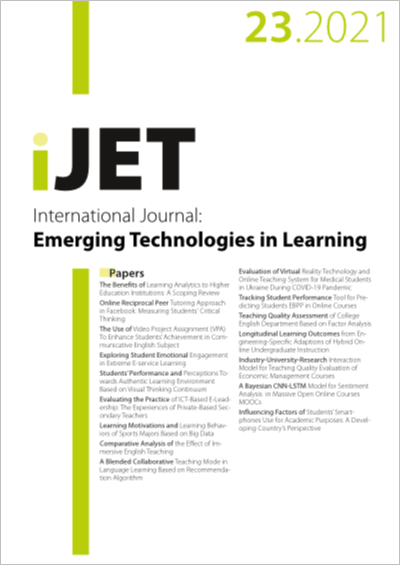The Use of Video Project Assignment (VPA) To Enhance Students’ Achievement in Communicative English Subject
DOI:
https://doi.org/10.3991/ijet.v16i23.27447Keywords:
Video Project Assignment, Communicative English, emotional engagement, cognitive engagement, students’ achievementAbstract
Speaking skills is a crucial element which all students in Malaysian polytechnic should master. The new English syllabus introduced in Polytechnic is aimed at building confidence and fluency in English for students as well as enabling them to function effectively at the workplace. Majority of the Communicative English assessment requires students to communicate in English either as individuals or in groups, but many students are still reluctant to speak in front of the classroom and have a very low level of confidence. Thus, Video Project Assignment (VPA) is implemented to boost the achievement of students in the field of Communicative English. The aims of this study are 1) to analyse the student’s perception on the use of Video Project Assignment (VPA) in Communicative English subject, 2) to examine students’ engagement level towards the use of Video Project Assignment (VPA) based on emotional engagement and cognitive engagement and 3) to identify students’ achievement in DUE3012 Communicative English 2 subject. A set of questionnaire was used to gather data from thirty-three respondents from one of the polytechnics in Johor. Descriptive analysis technique was used to analyzed the data gathered from questionnaire. Result of the study indicates that by generating Video Project Assignment (VPA), students demonstrate positive perception, engagement, and achievement. This study also provides the students, lecturers, and potential researcher with a good inference.
Downloads
Published
2021-12-08
How to Cite
Mohamed, K. A., Mohd Zaid, N., Ibrahim, N. H., Abdullah, A. H., Surif, J., & Hussin, A. J. (2021). The Use of Video Project Assignment (VPA) To Enhance Students’ Achievement in Communicative English Subject. International Journal of Emerging Technologies in Learning (iJET), 16(23), pp. 29–42. https://doi.org/10.3991/ijet.v16i23.27447
Issue
Section
Papers
License
Copyright (c) 2021 Norasykin Mohd Zaid, Kamarul Aina Mohamed, Nor Hasniza Ibrahim, Abdul Halim Abdullah, Johari Surif, Ainun Juhariah Hussin

This work is licensed under a Creative Commons Attribution 4.0 International License.



